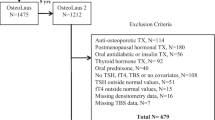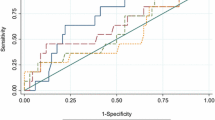Abstract
OBJECTIVE
The aim of our study was to evaluate the relationship between the elevated TSH and fracture risk in postmenopausal women with subclinical hypothyroidism for evaluation of individuals with a high risk for osteoporotic fractures.
DESIGN
FRAX score calculation (10-year estimated risk for bone fracture) and measurement of bone markers (osteocalcin and beta cross-laps) were performed in 82 postmenopausal women with newly discovered subclinical hypothyroidism (mean age 59.17±7.07, mean BMI 27.89±3.46kg/m2, menopause onset in 48.05±4.09 years of age) and 51 matched controls (mean age 59.69±5.72, mean BMI 27.68±4.66kg/m2, menopause onset in 48.53±4.58 years of age) with normal thyroid function.
RESULTS
The main FRAX score was significantly higher in the group with subclinical hypothyroidism than in the controls (6.50±4.58 vs. 4.35±1.56; p = 0.001). Hip FRAX score was significantly higher in the group with subclinical hypothyroidism (1.11±1.94 vs. 0.50±0.46; p=0.030). There was no significant difference in bone markers: osteocalcin (23.99±12.63 vs. 21.79±5.34 ng/mL; p=0.484) and beta cross-laps (365.76±184.84 vs. 306.88±110.73 pg/mL; p = 0.21) between the two groups.
CONCLUSIONS
Postmenopausal patients with subclinical hypothyroidism, in particular of autoimmune origin, have higher FRAX scores and a thus greater risk for low-trauma hip fracture than euthyroid postmenopausal women. Our results point to the need to monitor postmenopausal patients with subclinical hypothyroidism for avoidance of fractures.
Similar content being viewed by others

References
Gogakos AI, Duncan Bassett JH, Williams GR, 2010 Thyroid and bone. Arch Biochem. Biophys 503: 129–136.
Wojcicka A, Bassett JH, Williams GR, 2012 Mechanism of action of thyroid hormones in the skeleton. Biochim Biophys Acta (in press) https://doi.org/10.1016/j.bbagen.2012.05.005)
Williams GR, 2011 Extrathyroidal expression of TSH receptor. Ann Endocrinol 72: 68–73.
Mazziotti G, Porcelli T, Patelli I, Vescovi PP, Giustina A, 2010 Serum TSH values and risk of vertebral fractures in euthyroid post-menopausal women with low bone mineral density. Bone 46: 747–751.
Bassett JH, Williams GR, 2008 Critical role of the hypothalamic-pituitary-thyroid axis in bone. Bone 43: 418–426.
Lakatos P, 2003 Thyroid hormones: beneficial or deleterious for bone? Calcif Tissue Int 73: 205–209.
Duntas LH, 2003 Subclinical thyroid disorders: the menace of the Trojan horse. J Endocrinol Invest 26: 472–480.
Unnanuntan A, Gladnick BP, Donnelly E, Lane JM, 2010 The assessement of fracture risk. J Bone Joint Surg Am 92: 743–753.
Pearce EN, 2007 Thyroid dysfunction in perimenopausal and postmenopausal women. Menopause Int 13: 8–13.
Shidara K, Inaba M, 2009 Bone metabolic marker for osteoporosis. Nihon Rinsho 67: 927–931.
Kamel HK, Hussain MS, Tariq S, Perry HM, Morley JE, 2000 Failure to diagnose and treat osteoporosis in elderly patients hospitalized with hip fracture. Am J Med 109: 326–328.
Follin SL, Black JN, McDermott MT, 2003 Lack of diagnosis and treatment of osteoporosis in men and women after hip fracture. Pharmacotherapy 23: 190–198.
Gardner MJ, Brophy RH, Demetrakopoulos D, et al, 2005 Interventions to improve osteoporosis treatment following hip fracture. A prospective, randomized trial. J Bone Joint Surg Am 87: 3–7.
Kanis JA, Johnell O, Oden A, Johansson H, McCloskey E, 2008 FRAX and the assessment of fracture probability in men and women from the UK. Osteoporos Int 19: 385–397.
Baddoura R, Hoteit M, El-Hajj Fuleihan G, 2011 Osteoporotic fracture, DXA, and fracture risk assessment: Meeting future challenges in the Eastern Mediterranean region. J Clin Densitom 14: 384–394.
Leslie WD, Lix LM, Langsetmo L, et al, 2011 Construction of a FRAX® model for the assessment of fracture probability in Canada and implications for treatment. Osteoporos Int 22: 817–827.
Dawson-Hughes B, Tosteson AN, Melton LJ 3rd, et al, 2008 Implications of absolute fracture risk assessment for osteoporosis practice guidelines in the USA, Osteoporos Int 19: 449–458.
Lau B, Cole SR, Gange SJ, 2009 Competing risk regression models for epidemiologic data. Am J Epidemiol 170: 244–256.
Kanis JA, Johnell O, Johansson H, et al, 2006 Prior clinical vertebral fractures are a particularly strong predictor of hip fracture: a meta-analysis. Osteoporosis Int 17: Suppl 3: 365.
Watts NB, 2011 The Fracture Risk Assessment Tool (FRAX®): applications in clinical practice. J Womens Health (Larchmt) 20: 525–531.
Leslie WD, Majumdar SR, Lix LM, 2012 High fracture probability with FRAX usually indicates densitometric osteoporosis: implications for clinical practice. Osteoporos Int 23: 391–397.
Illias I, Spanoudi F, Koukkou E, Nikopoulou SC, 2012 Use of FRAX calculator with and without bone mineral density in Greek women. Hormones (Athens) 11: 222–223.
Cauley JA, El-Hajj Fuleihan G, Arabi A, et al, 2011 Official Positions for FRAX® clinical regarding International differences from Joint Official Positions Development Conference of the International Society for Clinical Densitometry and International Osteoporosis Foundationma on FRAX. J Clin Densitom 14: 240–262.
Pirro M, Manfredelli MR, Scarponi AM, et al, 2012 Association between thyroid hormone levels, the number of circulating osteoprogenitor cells, and bone mineral density in euthyroid postmenopausal women. Metabolism 61: 569–576.
Lippuner K, Johansson H, Kanis JA, Rizzoli R, 2009 Remaining lifetime and absolute 10-year probabilities of osteoporotic fracture in Swiss men and women. Osteoporos Int 20: 1131–1140.
Mayer J, 2007 The association between serum thyroid-stimulating hormones in its reference range and bone status in postmenopausal American women. Bone 40: 1128–1134.
Greet R, Bruno L, Stefan G, 2011 Thyroid hormone status within the physiological range affects bone mass and density in healthy men at the age of peak bone mass. Europ J Endocinol 164: 1027–1034.
Novack, D, 2003 TSH, the bone suppressing hormone. Cell 115: 129–130.
Sun L, Davies TF, Blair HC, Abe E, Zaidi M, 2006 TSH and bone loss. Ann N Y Acad Sci 1068: 309–318.
Bauer DC, 2009 Bone: does TSH concentration influence skeletal health? Nat Rev Endocrinol 5: 245–246.
Schett G, David JP, 2010 The multiple faces of autoimmune-mediated bone loss. Nat Rev Endocrinol 6: 698–706.
Grimnes G, Emaus N, Joakimsen RM, Figenschau Y, Yorde R, 2008 The relationship between serum TSH and bone mineral density in men and postmenopausal women: the Tromso study. Thyroid 18: 1147–1155.
Mosekilde L, Eriksen EF, Charles P, 1990 Effects of thyroid hormones on bone and mineral metabolism. Endocrinol Metab Clin North Am 19: 35–63.
Abe E, Marians RC, Yu W, et al, 2003 TSH is a negative regulator of skeletal remodeling. Cell 115: 151–162.
Nagata M, Suzuki A, Sekiguchi S, et al, 2007 Subclinical hypothyroidism is related to lower heel QUS in postmenopausal women. Endocr J 54: 625–630.
Zaidi M, Davies TF, Zallone A, et al, 2009 Thyroid-stimulating hormone, thyroid hormones, and bone loss. Curr Osteoporos Rep 7: 47–52.
Heemstra KA, van der Deure WM, Peeters RP, et al, 2008 Thyroid hormone independent associations between serum TSH levels and indicators of bone turnover in cured patients with differentiated thyroid carcinoma. Eur J Endocrinol. 159(1):69–76.
Fadejev VV, Morgunova TB, Melnichenko GA, Dedov II, 2010 Combined therapy with L-Thyroxine and L-Triiodthyronine compared to L-Thyroxine alone in the treatment of primary hypothyroidism. Hormones (Athens) 9: 245–252.
Polovina S, Tucic-Nemet K, Pletikosic I, Obradovic A, 2009 The influence of thyroxin replacement therapy on bone mineral density in hypothyroid subjects. Endocrine Abstracts 11th European Congress of Endocrinology, 25–29 April, Istanbul, Turkey 20, p58.
Milne M, Kang MI, Quail JM, Baran DT, 1998 Thyroid hormone excess increases insulin-like growth factor I transcripts in bone marrow cell cultures: divergent effects on vertebral and femoral cell cultures. Endocrinology 139: 2527–2534.
Suwanwalaikorn S, Ongphiphadhanakul B, Bravenman LE, Baran DT, 1996 Differential responses of femoral and vertebral bones to long-term excessive L-Thyroxine administration in adults’ rats. Eur J Endocrinol 134: 655–659.
Bertoli A, Fusco A, Andreoli A, et al, 2002 Effect of subclinical hypothyroidism and obesity on whole-body and regional bone mineral content. Horm Res 57: 79–84.
Lee WY, Oh KW, Rhee EJ, et al, 2006 Relationship between subclinical thyroid dysfunction and femoral neck bone mineral density in women. Arch Med Res 37: 511–516.
Rasic-Milutinovic Z, Milicevic D, Gluvic Z, et al, 2008 Subclinical hypothyroidism and bone mineral density. Endocrine abstracts 16:75.
Johnell ü, Kanis JA, Oden A, et al, 2005 Predictive value of BMD for hip and other fractures. J Bone Miner Res 20: 1185–1194.
De Laet C, Oden A, Johnell O, Jonsson B, Kanis JA, 2005 The impact of the use of multiple risk factors on case finding strategies: a mathematical framework. Osteoporosis Int 16: 313–318.
De Laet C, Kanis JA, Oden A, et al, 2005 Body mass index as a predictor of fracture risk: a meta-analysis. Osteoporosis Int 16: 1330–1338.
Vestergaard P, Rejnmark L, Mosekilde L, 2005 Influence of hyper and hypothyroidism, and the effects of treatment with antithyroid drugs and levothyroxine on fracture risk. Calcif Tissue Int 77: 139–144.
Singh A, Mehdi AA, Srivastava RN, Verma NS, 2012 Immunoregulation of bone remodeling. Int J Crit Illn Inj Sci 2: 75–81.
Lee JS, Buzkova P, Fink HA, et al, 2010. Subclinical thyroid dysfunction and incident hip fracture in older adults. Arch Intern Med 170: 1876–83.
Vestergaard P, Mosekilde L, 2002 Fractures in patients with hyperthyroidism and hypothyroidism: a nationwide follow-up study in 16,249 patients. Thyroid 12: 411–419.
Botella-Carretero JI, Alvarez-Blasco F, San Millan JL, et al, 2007 Thyroid hormone deficiency and postmenopausal stratus independently increase serum osteoprotegerin concentrations in women. Europ J of Endocinol 156: 539–545.
Lee J, Vasikaran S, 2012 Current recommendation for laboratory testing and use of bone turnover markers on management of osteoporosis. Ann Lab Med 32: 105–112.
Tromp AM, Ooms ME, Popp-Snijders C, Roos JC, Lips P, 2000 Predictors of fractures in elderly women. Osteoporos Int 11: 134–140.
Ross PD, Kress BC, Parson RE, Wasnich RD, Armour KA, Mizrahi IA, 2000 Serum bone alkaline phosphatase and calcaneus bone density predict fractures: a prospective study. Osteoporos Int 11: 76–82.
Van Daele PL, Seibel MJ, Burger H, et al, 1996 Case-control analysis of bone resorption markers, disability, and hip fracture risk: the Rotterdam study. BMJ 312: 482–483.
Chapurlat RD, Garnero P, Bréart G, Meunier PJ, Delmas PD, 2000 Serum type I collagen breakdown product (serum CTX) predicts hip fracture risk in elderly women: the EPIDOS study. Bone 27: 283–286.
Greenfield DM, Hannon RA, Eastell R 2001 The association between bone turnover and fracture risk (The Sheffield Osteoporosis study). In: Eastell R, Baumann M, Hoyle N, Wieczorek L (eds) Bone markers — biochemical and clinical perspectives. Martin Dunitz, London; pp, 225–236.
Bauer DC, Garnero P, Harrison SL, et al, 2009 Biochemical markers of bone turnover, hip bone loss, and fracture in older men: the MrOS study. J Bone Miner Res 24: 2032–2038.
Martini G, Gennari L, De Paola V, et al, 2008 The effects of recombinant TSH on bone turnover markers and serum osteoprotegerin and RANKL levels. Thyroid 18: 455–460.
Biver E, Chopin F, Coiffeier G. et al. 2012 Bone turnover markers for osteoporotic status assessment? A systemic review of their diagnosis value at baseline in osteoporosis. Joint Bone Spine 79: 20–25.
Author information
Authors and Affiliations
Corresponding author
Rights and permissions
About this article
Cite this article
Polovina, S., Popovic, V., Duntas, L. et al. Frax score calculations in postmenopausal women with subclinical hypothyroidism. Hormones 12, 439–448 (2013). https://doi.org/10.1007/BF03401309
Received:
Accepted:
Published:
Issue Date:
DOI: https://doi.org/10.1007/BF03401309



